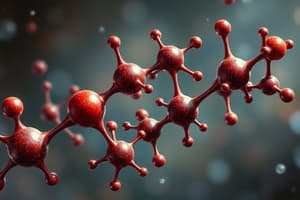Podcast
Questions and Answers
What is the primary function of carbohydrates?
What is the primary function of carbohydrates?
- Genetic information
- Ready energy (correct)
- Stored energy
- Structure
What process involves making a larger molecule by removing water?
What process involves making a larger molecule by removing water?
Dehydration synthesis
Saturated fats are liquid at room temperature.
Saturated fats are liquid at room temperature.
False (B)
Match the following biomolecules with their primary functions:
Match the following biomolecules with their primary functions:
Lipids are also known as __________.
Lipids are also known as __________.
Which of the following foods are considered high in fat?
Which of the following foods are considered high in fat?
All proteins are made from the same set of amino acids.
All proteins are made from the same set of amino acids.
What are the two types of nucleic acids mentioned?
What are the two types of nucleic acids mentioned?
The total number of different amino acids used to build proteins is _____
The total number of different amino acids used to build proteins is _____
Match the following terms with their descriptions:
Match the following terms with their descriptions:
Which type of fat is not mentioned as a high fat food?
Which type of fat is not mentioned as a high fat food?
DNA is shorter than RNA.
DNA is shorter than RNA.
What is the main purpose of proteins?
What is the main purpose of proteins?
Flashcards are hidden until you start studying
Study Notes
Organic Chemistry
- Organic chemistry specifically involves the study of carbon-based compounds.
- The term "organic" in a non-scientific context often refers to natural products, devoid of additives like preservatives, hormones, or pesticides.
Biomolecules
- Four essential biomolecules are crucial for life: proteins, lipids, carbohydrates, and nucleic acids.
- Proteins primarily contribute to structure.
- Lipids serve as stored energy.
- Carbohydrates provide readily available energy.
- Nucleic acids carry genetic information.
Carbon
- Carbon occupies group four on the periodic table.
- It requires four electrons to complete its outer electron shell, forming four covalent bonds.
- Carbon's fundamental role in organic molecules led to the designation "organic" for carbon compounds.
Processes Involving Biomolecule Formation
- Dehydration synthesis: Joining smaller molecules by removing water to create a larger molecule.
- Hydrolysis: Breaking down a larger molecule into smaller ones by adding water.
- ATP (adenosine triphosphate) serves as the primary energy carrier in biological processes.
Carbohydrates
- Carbohydrates consist of carbon and water components.
- They function as readily available energy sources.
- Simple carbohydrates (sugars) include monosaccharides and disaccharides.
- Glucose (C6H12O6) is a prevalent example of a monosaccharide.
- Complex carbohydrates (starches) encompass polysaccharides like those found in bread, pasta, potatoes, etc.
Lipids (Fats)
- Lipids function as stored energy and contribute to insulation.
- Their structure involves a glycerol molecule bonded to three fatty acids.
- Examples of lipids include fats (triglycerides), phospholipids, waxes, and steroids.
Types of Lipids
- Saturated fats are fully saturated with hydrogen, containing only single bonds between carbon atoms. They form larger molecules, solidify at room temperature, and can potentially contribute to artery blockages. Examples include animal fats.
- Unsaturated fats lack the maximum amount of hydrogen bonds, typically remaining liquid at room temperature. Examples encompass vegetable oils, with subgroups like cis, trans, and omega-3 fats.
Proteins
- Serve as structural components.
- Composed of chains of amino acids (typically 500-2000 amino acids long).
- There are 20 unique amino acids, likened to "letters" forming "words."
- Enzymes are proteins that regulate various biological processes.
Protein Examples
- Lean meats, fish, egg whites, milk, nuts, and certain vegetables (though many do not have all 20 amino acids) are protein sources.
Protein Diversity
- Protein variation stems from differences in:
- The number of amino acids in a chain (length).
- The types of amino acids present.
- The order (arrangement) of amino acids in the chain.
Nucleic Acids
- Serve as "blueprints of life," providing instructions for protein synthesis.
- Two main types: DNA (Deoxyribonucleic Acid) and RNA (Ribonucleic Acid).
Nucleic Acid Composition
- Nucleic acids are composed of nucleotides.
- Each nucleotide comprises a sugar molecule, a phosphate group, and a nitrogenous base (Adenine [A], Thymine [T], Guanine [G], Cytosine [C] for DNA; Uracil [U] replaces Thymine in RNA).
DNA vs. RNA
| Feature | DNA | RNA |
|---|---|---|
| Sugar | Deoxyribose | Ribose |
| Nitrogenous Bases | ATGC | AUGC |
| Length | Longer | Shorter |
| Structure | Double Strand (helix) | Single Strand |
| Location | Primarily in nucleus | Can travel out of nucleus |
Watson and Crick (1953)
- James Watson and Francis Crick proposed the double helix structure of DNA.
Nutrition
- The study of nutrients encompasses vitamins and minerals.
Maintaining a Healthy Weight
- Weight management depends on balancing calorie intake and calorie expenditure.
- This equilibrium is disrupted if a food item does not satisfy hunger, leading to further consumption and calorie surplus.
Studying That Suits You
Use AI to generate personalized quizzes and flashcards to suit your learning preferences.




